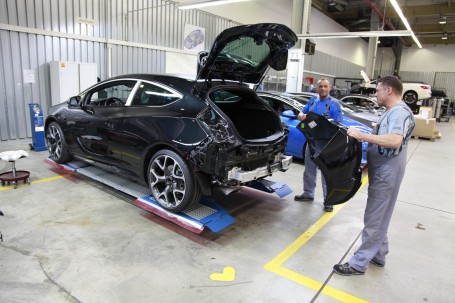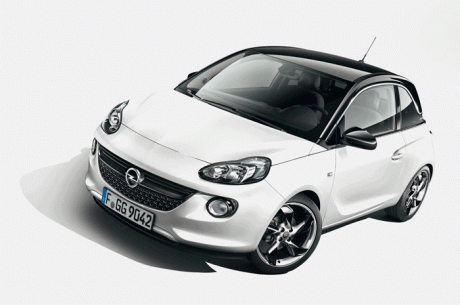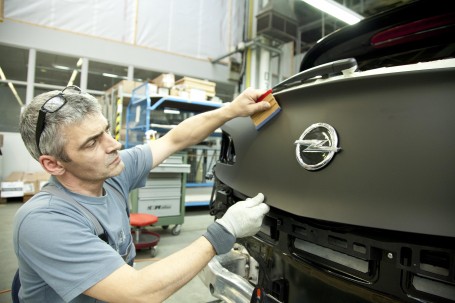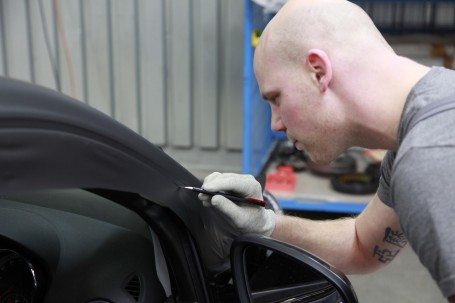- Der Kreativität sind keine Grenzen gesetzt: Bei einer Folierung sind alle Farben, Muster und Bilder möglich.
As he approaches the trickiest spot, the expression on Christof Hojsan’s face looks like something out of one of Sergio Leone’s Spaghetti Westerns. The jaw muscles are tensed, the mouth pinched, the forehead beaded with sweat. The area around Hojsan’s eyes is twitching, yet he does not blink. Is he breathing? Not more than necessary! Nothing should be allowed to disrupt his concentration, even if he is not looking down the barrel of a gun, but at the front bumper of an Astra OPC.
The car part hangs on a meter-high metal rack, specially installed for this purpose. While working earlier on the roof and the doors, Hojsan looked quite relaxed. He handled these even surfaces with his colleague, Iwan Krauberger. But the party’s over now.
PRECISION WORK WITH TWEEZERS
The front section measures around two square meters and, with its many openings, corners, beading and grooves, is just waiting to be messed up. But Hojsan is not fazed. He works with fluid hand movements and a firm grip. Centimeter by centimeter, obstacle by obstacle, he covers the tricky areas with a self-adhesive, matte black car film. They have been pre-cut and must now be applied around three millimeters around the edges so that the original paint underneath is no longer visible. Hojsan rips the film off from many spots where there is too much material, using a plain pair of tweezers. This takes several minutes. “You need a delicate hand and stay as calm and cool as possible,” he says. “Once you lose your concentration, mistakes start to happen – bad ones.”
While he applies the film, Blasius tries to prevent air bubbles and wrinkles from forming between it and the surface underneath. This saves precious minutes that would otherwise need to be spent going over it with a squeegee and an industrial blower. “In our job, time is the most important factor, apart from a precise and clean result.” Hojsan and Krauberger are part of an eight-member car wrapping team at Opel Special Vehicles GmbH (OSV), a Rüsselsheim-based subsidiary of Opel whose motto is ‘individuality ex factory.’ The OSV employees handle vehicle installations and modifications ranging from sporty OPC trim and natural gas or liquefied petroleum gas technology to tailored solutions for public authorities, taxi companies, the police, and EMT and ambulance services.

Disassembling for precision: Kai Blasius (left) and Ralf Diehl take apart components such as bumpers, lights, and mirrors. These need to be secured to special brackets and wrapped individually in order to achieve absolutely precise results.
OSV has been offering ‘car wrapping,’ as it is known in the business, since 2012. The team’s strikingly clean work area is half the size of a soccer field. It is part of the huge hall complex of the M55 building on the grounds of the Opel plant. The walls surrounding the area are around three meters high, with openings covered in a thick layer of protective film. “It is strictly forbidden for air currents or even the tiniest speck of dust to enter here,” says Peter Raabe, who is in charge of the department. “The car film is statically charged and would attract all of the particles in the air as soon as the backing is removed. This would be disastrous for the wrapping process.” This is also why the floor is wet mopped several times throughout the day. Another thing that makes this part of the hall different than the rest is the temperature. The thermometer reads a comfortable 22 degrees Celsius all year round, reports Raabe. “This is the only way to achieve the best film adhesion.”

Door handles are exposed to heavy use and scratches of all kinds, and are not wrapped due the extremely high risk of wear and tear. Instead, the handles are replaced with new ones that have been treated with an anti-corrosion base coat and painted in the same color as the film.
An important event took place last year in June that brought good fortune to the OSV wrapping team. For the visit of King Willem-Alexander and Queen Máxima of the Netherlands, Hojsan, Krauberger, and their colleagues gave an Ampera and a Cascada a second skin in deep orange. Photos of the smiling royals with the vehicles made it onto the television news. Ever since, ‘royal orange’ has been a regular color in the portfolio, and the demand for wrapping has increased considerably. “We advise customers in selecting patterns and colors,” says Peter Raabe. The carbon look is one of the most popular designs. Anything is possible, from simple colors such as metallic blue and matte red, to imitation crocodile.
CUTTING FILM ON A BALLOON
The wrapping film consists of dual layer molded plastic. The material is polyvinyl chloride, which sounds pretty fancy but is commonly known as PVC. “This stuff is why we talk about 3D film,” explains Raabe. “The term is used to refer to films that are so stretchy and elastic that they can cling to the contours of three-dimensional objects.” OSV uses film that is on average 90 µm (micrometers) thick, which is equal to 0.09 millimeters. In order to handle such an incredibly thin material, you need a certain amount of skill and a cool head, as Raabe sees it. “The work these guys produce is of the finest craftsmanship.” He recruited the team members two years ago using somewhat spectacular hiring tests. The candidates were given a sharp cutter and instructed to slice the film – which was wrapped around a balloon.
Hojsan was among the ones who did not burst the balloon. Now he smiles. He has emerged victorious from the duel with the front bumper of the Astra OPC and its multitude of tricky details. Time for a short break. He goes out for some fresh air, which he does every two or three hours. He blinks a few times and says, “The eyes need a couple minutes’ rest.” He would not recommend the job to just anyone. “You have to be capable and find it enjoyable to concentrate totally on a single thing for hours, like we do.” Blasius returns to the hall and puts his Spaghetti Western face back on. The rear bumper is waiting for him.
What are the pros of having 3D film applied to a vehicle?
“There are six good reasons!” says Hans-Jürgen Michel, head of OSV GmbH. Here they are:
1 Cheaper: Wrapping is less than half the cost of a new paint job.
2 Design variety: Any color, pattern, and image can be used, including pictures of your pet or girlfriend.
3 Protection: The paint is protected from dings and scratches, increasing your car’s resale value.
4 Suitable for everyday use: It is safe to put wrapped cars through a car wash and damage to the film can be quickly repaired.
5 Quality: When performed ex factory at Opel, it comes with high-quality craftsmanship and a two-year guarantee.
6 Happy ending: The film lasts up to five years and can be removed without leaving any residue.



